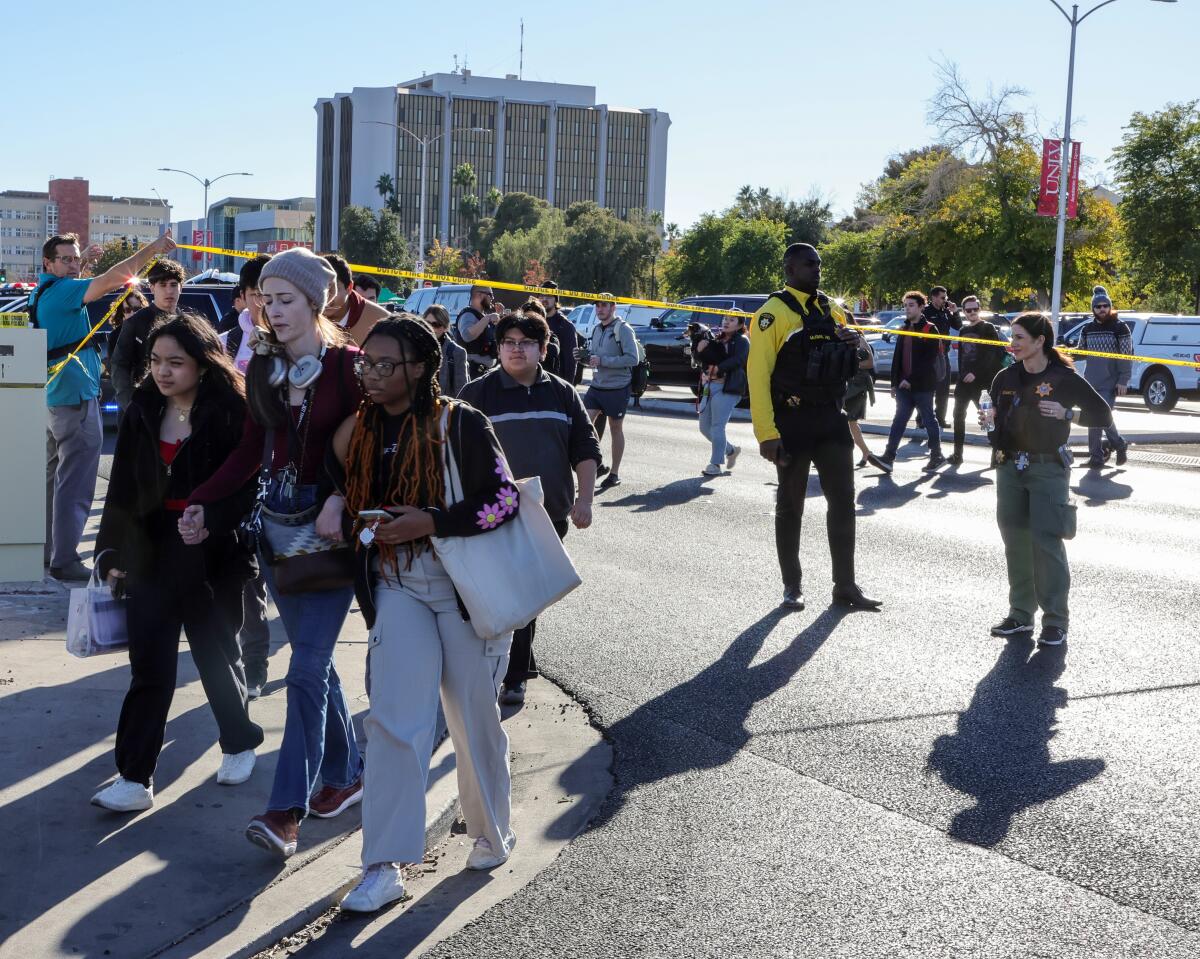In wake of UNLV, how California colleges gird against active shooters

- Share via
As another mass shooting traumatizes a college campus — this time the University of Nevada, Las Vegas — California universities have developed a set of tools, including video trainings, text alerts and enhanced door locks, to protect their students, faculty and staff.
The UNLV shooting that left three dead and one injured comes as all University of California campuses are currently providing “refresher training” on active shooter situations for communities and first responders — a task made more urgent Wednesday, said UC Davis Police Chief Joe Farrow, coordinator of the UC Council of Police Chiefs.
He said requests for campus trainings have escalated in recent weeks due to rising tensions over the Israel-Hamas war, which has triggered multiple rallies and reports of vandalism, violence, harassment and threats on both sides.
Now, he said, campus security needs to be alert for any incidents that might be inspired by the violence at UNLV.
“I’m not sure about copycat acts, but there are probably some people who look at that and think that’s the solution to their problems,” he said.
“Our hearts and prayers go out to UNLV. They have just suffered every community’s greatest nightmare,” he said. “First responders across America train constantly to prevent and respond to these horrific incidents. We are all saddened by yet another senseless act.”
The UNLV shooting took place about noon Wednesday a few miles from the Las Vegas Strip.
It was the latest of at least nine other mass shootings at or near college campuses in the last 15 years — including one at Michigan State University in February, where the gunman killed three students and injured five others, and Morgan State University during homecoming week in October, which injured five people.
Preparing for an active shooter at colleges has been a regular part of safety planning for nearly two decades in California — home to the nation’s largest systems of public higher education and a state that has experienced its share of campus tragedies.
In 2016, a UCLA professor was fatally shot in his office by a former doctoral student. In 2014, a man killed six UC Santa Barbara students in the nearby town of Isla Vista and wounded 14 others before shooting himself in the head at the wheel of a BMW. In 2013, a gunman killed five people and injured three others in a shooting rampage that ended at Santa Monica College. At Cal State Fullerton in 1976, seven people were killed by a custodian who stormed the library.
In one common protocol at colleges, UNLV students said they received emergency messages from the university at 11:51 a.m. Jason Whipple Kelly, a second-year law school student at UNLV, was walking onto campus to take a final exam when he saw the text:
“University Police responding to report of shots fire in BEH evacuate to safe area, RUN-HIDE-FIGHT.” He soon heard sirens and he saw police run onto campus. “I was walking to the law school, got the text and turned around and ran back to the car,” he said.
He praised the university communication, saying updates and instructions were sent out every couple of minutes.
Another law student, Carlos Eduardo Espina, said in the midst of the emergency, some students were confused by the messaging about the shooter’s location, leading them to believe there was a second shooter on campus.
The 10-campus UC and 23-campus California State University systems generally share the same practices for responding to active shooters. UC offers a list of resources on how to handle active shooters, including online classes, instructional pocket cards and video trainings by the FBI and other federal agencies.
The UC website advised students to keep three key words in mind: Run, hide, fight.”
UC campuses have worked to improve safety by upgrading technology, enhancing training and adding unarmed security officers, mental health professionals and other resources to supplement their sworn police forces, Farrow said.
Here is more about how California’s colleges prepare for that possibility.
What are colleges required to do to protect students?
Under the Clery Act, a federal law enacted in 1990 and expanded since then, each time a school is notified of a campus crime, an official must review the crime and decide if it represents a “serious or ongoing” threat. All higher-education institutions — public and private — that receive money for federal student aid programs are required by law to follow the Clery Act.
If the threat is deemed serious or ongoing, the school must issue a timely warning to the entire campus.
Colleges and universities must also establish and put into effect emergency responses and notification systems. They must inform the school community about any “significant emergency or dangerous situations involving an immediate threat to the health or safety of students or employees on the campus.” That includes shootings, fires, earthquakes and crimes of sexual violence.
Campus police agencies are required to have a rapid response plan for mass shootings, said Melinda Latas, director of campus safety compliance for CSU. Those plans, which are posted to school websites, detail how authorities manage the first response in a shooting and how campuses must train for them.
The federal law was named for Jeanne Clery, a first-year student at Lehigh University in Pennsylvania, who in 1986 was sexually assaulted and killed in her dorm room by another student she did not know.
What does training look like?
Training is critically important, for both security officers and the wider community, campus security experts said.
Cal State Fullerton holds an active shooter drill every two years in specific locations on campus, such as a parking structure or the student union, Police Capt. Scot Willey said. The university trains about 200 students on run, hide, fight procedures. During one drill, Willey said, a police officer is dressed in a padded suit while carrying a rubber rifle. Students are taught where to run and locations that are good for hiding. They’re also taught to use items around them — staplers, laptops, iPads — to fend off an attacker if there are no other options.
At UC Davis, students are given training on active shooter situations during required orientations; the workshops are also available to all campus members.
Students are taught to silence their cellphones, although it helps officers when people message about what is happening in their part of campus, as first responders are sometimes “going in blind,” Farrow said.
What security challenges do open campuses present?
Unlike K-12 schools, public college campuses are not gated, with access open to anyone.
“You don’t know everybody that comes on your campus,” Farrow said. “That’s the disadvantage that you have, and that’s what they experienced in Michigan State.”
When police receive the first reports of a shooter on campus, the protocols are generally consistent across universities, Farrow said. The dispatchers write up a notification that an active shooter is present, giving a location if known, and urge people to leave the area or shelter in place. This is automatically sent to the entire campus community and to parents and families who have signed up for such notifications, Farrow said.
How has the technology evolved?
Improvements to technology, including enhanced door-locking systems and closed-circuit cameras that help authorities identify potential shooters, have helped campuses to be better prepared.
Notification systems that allow campuses to send out mass alerts are mandatory for all higher-education institutions, said John Ojeisekhoba, president of the International Assn. of Campus Law Enforcement Administrators.
At Cal State Fullerton, police can consult hundreds of surveillance cameras throughout the campus, Willey said. The school can blast “shelter in place” warnings over indoor and outdoor speakers, along with sending email and text alerts.
“Text is the most efficient thing that we can use and probably the quickest way that we can communicate with our community,” he said.
Under UC Davis Chancellor Gary May, the campus has launched a $32-million, seven-year plan to enhance security with such technology as an automatic door-locking system, allowing officials to close all buildings simultaneously rather than having to use individual keys.
UC Davis also has added a sophisticated camera system that monitors public access. Other U.S. campuses have invested in “shot spotter” devices that detect gunshots and quickly identify where they are coming from, Farrow said.
UC Davis has increased unarmed security officers on its safety staff. The officers help patrol the campus, check building locks and escort students to classes and dorms when requested; some are trained to take down crime reports.
Similar steps are being taken throughout the UC system as President Michael V. Drake has led efforts to reshape campus safety practices by supplementing the traditional reliance on sworn police officers.
“One thing all chancellors say is that we have to keep these open campuses as safe as we can,” Farrow said.
More to Read
Sign up for Essential California
The most important California stories and recommendations in your inbox every morning.
You may occasionally receive promotional content from the Los Angeles Times.














